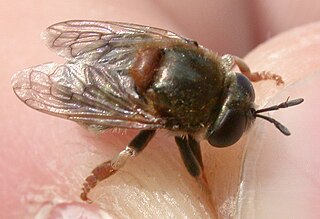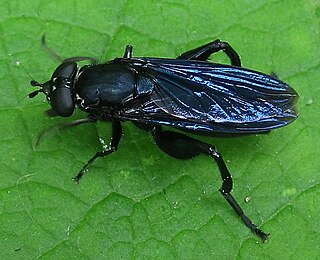
The subfamily Microdontinae contains slightly more than 400 species of hoverflies and, while diverse, these species share several characteristics by which they differ from other syrphids. The Microdontinae are myrmecophiles, meaning they live in the nests of ants. Larval Microdontinae are scavengers or predators in ant nests, and, in contrast to other syrphid larvae, have no readily apparent body segmentation. Some species also do not exhibit the typical adult flower-visiting behaviour of other hoverflies, but instead remain near their larval host colonies.

Hover flies of the genus Microdon are unusual among the Diptera. Like other members of the subfamily, they are myrmecophiles, meaning they inhabit the nests of ants.

Syritta is a genus of hoverflies, family Syrphidae.

Rhingia is a genus of hoverflies. They all have a very distinctive long snout. The larvae are associated with animal dung. Adults feed on nectar and pollen.

Xylota is a Holarctic genus of hoverflies similar in structure to the related genera Chalcosyrphus and Brachypalpoides. As the larvae are saprophytic they're usually found in rotting wood. The adult flies are generally associated with woodland and woodland edges and can often be seen running over the upper sides of leaves. Unlike other syrphids the adults of many species rarely visit flowers preferring instead to gather pollen from leaf surfaces. There are over 100 described species of which 12 can be found in Europe. Seven species have been recorded in Britain. Identification of species has been difficult and identification by photographs is risky.

Cheilosia is a genus of hoverfly. Most Cheilosia are black or largely un-coloured, lacking the bright colours and patterns of many hoverfly species. It is one of the most species diverse genera of hoverflies. The biology of many species is little understood, but where known, the larvae of Cheilosia species feed in the stems of plants or in fungi.

Eumerus is a genus of hoverflies, within the tribe Eumerini.

Temnostoma is a genus of hoverflies. The larvae of some species feed on the wood of deciduous trees.

Platycheirus is a large genus of hoverflies. They are also called sedgesitters. The genus Platycheirus was established in 1828 by Lepeletier and Serville, with the type specimen of Syrphus scutatus Meigen. This genus is primarily Holarctic in distribution, encompassing 70 species within the Nearctic region. Notably, at least 23 of these Nearctic species are also found in the Palearctic realm, with their approximately 110 species.The distribution of Platycheirus is markedly boreal, with half of the 70 Nearctic species in the Yukon, Northwest Territories, or Alaska. The genus is widespread from Mexico, Central and South America, Europe, Asia, Southeast Asia, Platycheirus are not found in Australia, Indonesia and New Guinea. The genus has a variety of food choices for larvae, ranging from generalized aphid predators to species that specialize in feeding on one or two specific aphid species. Most are feeding within the ground layer of leaf litter.

Sphaerophoria is a genus of hoverflies.

Criorhina is a genus of hoverflies. Medium to large sized species, black or greenish black, with or without light ground markings mimicking bumblebees. The head is much flattened and broader than the thorax. The antennae are situated upon a prominent conical frontal process, The face is moderately produced below the eyes, downward or forward, in profile. The eyes are bare. The abdomen is elliptical or very short oval. Larvae found in rot holes or decaying hardwoods

Blera is primarily a North American genus, though there are 3 species from Europe. The genus is characterized by the following characters:

Chalcosyrphus is a genus of hoverflies in the subfamily Eristalinae. Many species exhibit some degree of mimicry of various sawflies and other hymenopterans and are often brightly coloured or metallic in hue. The adults are similar in structure and behavior to the related genus Xylota but differ in larval morphology. They can be found throughout Europe, Asia, and North America and seem to prefer damper, boggy habitats. The larvae are saproxylic feeders in rotten wood in these habitats.

Episyrphus is a genus of hoverflies in the subfamily Syrphinae. Larvae are predatory, often on aphids.

Tropidia is a genus hoverflies, from the family Syrphidae, in the order Diptera.
Archimicrodon is a genus of hoverflies. Many of the species in this genus were moved from Microdon by Reemer & Ståhls (2013). Previously, it had been described as having three known species.

Milesia is a genus of very large hoverflies, which mimic social wasps. For example, the European species Milesia crabroniformis is a convincing mimic of the hornet species Vespa crabro. Milesia are predominantly Palaeotropical in distribution almost entirely Oriental.

Ocyptamus is a large and diverse genus of over 200 species of hoverfly mostly found in the Neotropical region. It is likely that many of these species will be discovered to be synonyms though many others await description.

Graptomyza is a genus of hoverflies.

















